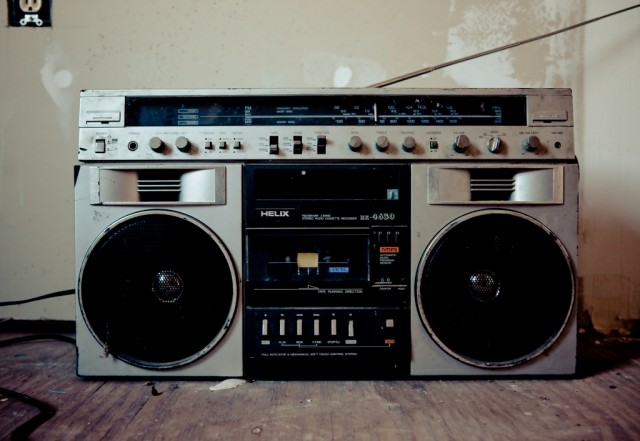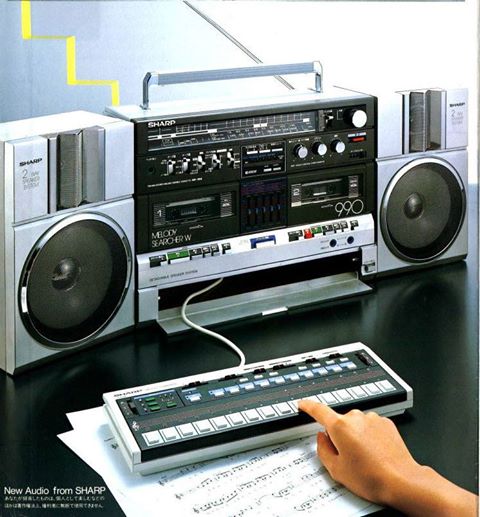
Reasonably stylish, definitely portable, interesting concept – and, unfortunately, not terribly practical. But on the bright side, we can use this opportunity to reminisce about 80s “ghettoblasters” as Philips calls this, and snicker at their ad copy. Result! Image courtesy Philips.
In the latest megarich DJ – electronics manufacturer collaboration, we find Dutch giant Philips with Armin van Buren. (In fact, you might begin to wonder if these guys are just competing over the Forbes highest-paid DJs list.)
This time, what you get is an all-in-one iPad dock with DJ control surface with speaker. That in itself seems not such a terrible idea, but then the problems start. Apart from the usual concerns about obsolete dock devices, the dock slot here places the iPad in an uncomfortable vertical position. There are physical controls for DJing, too, integrated with the (rather excellent) DJ app Algoriddim djay. But as a boombox, the awkwardly-named M1X-DJ is expensive and underpowered: EUR399.95 buys you just 80 watts of sound, in a box that fails to give you any stereo separation. At least the speakers appear to face away from the DJ and not only toward, but it’s unclear how any element of this all-in-one combination is helpful to anyone.

More like this, please. Really. (Skip the Philips/Armin business to the end of the story for some nostalgia.) Photo (CC-BY-ND) Sean Davis.
Bizarrely, Armin himself argues that somehow all of this saves you money:
“Fans often ask me what equipment they should buy when they want to start mixing themselves,” said Armin. “A lot of kit can be expensive, so with the M1X I wanted to create something that’s accessible for everybody. The other great thing about the M1X is that you can play it wherever you want, whether that’s the beach, the park or your street: it’s the ghettoblaster reinvented for today.”
Philips and Armin van Buuren launch DJ sound system [Philips at IFA Berlin]
Of course, there are other solutions to this problem, broadly falling under the product category of “speakers.” If your budget is five hundred bucks, serious users and amateurs alike will easily find better choices.
If you must have a controller, Numark makes one for djay that has the iPad in a more logical horizontal position, and with better controls. Or there’s the more-portable Native Instruments Kontrol Z1, which also boasts an audio interface with a separate headphone jack and doesn’t use a dock. (It also works nicely with your desktop; I’ve been using one with Ableton Live. More on it later.)
And for a fraction of the price of the M1X-DJ, any local electronics store will gladly sell you portable boomboxes that are cheaper, more powerful, and still battery-powered – and your iPad or iPhone (or whatever) can simply talk to them via Bluetooth. So, rather than hovering over a speaker with an iPad stuck in it looking like you’re trying to pretend you’re a DJ, you can just pop djay, Traktor, or your favorite iOS DJ app onto your iThing and hang around with friends. You could be turning hot dogs on the grill or floating in the pool cueing tracks. (The M1X-DJ has Bluetooth, too, but that defeats the purpose of buying this as a dock and controller – and as a speaker, it just seems it’s not worth the money.)
Speaking of your friends, Philips may also want to consider double-checking their copy writer. A caption for one of the images proudly proclaims – and I’m quoting exactly what they wrote here:
“Create incredible sets that will blow your friends.”
I’m hoping that right now there isn’t a big color box design for this thing sitting on a desk in Eindhoven that says “M1X-DJ: Blow Your Friends with Armin Van Buren.”
Anyway, we wouldn’t bother to cover this at CDM except that it’s a great excuse to talk about how much cooler boomboxes were in the 1980s. Four examples:
Boombox with drum machine. There’s the Lehnert Studio-5000 / Tensai Rhythm Machine CR-390 from 1977/78, which incorporated a rhythm generator / drum machine with analog circuitry.
As seen on Matrixsynth:
Tensai rhythm machine, 80s boombox with drum machine
Boombox with synth. Apart from the usual (and impressive) complement of standard features on 80s boomboxes (dual cassette, dual-band radio, aux jacks), the Sharp MR-990 tucked a small keyboard synth with pattern sequencing features into the case. I’m the operator with my pocket … yeah, you know.
In a surprising show of elegance, they even built an eject mechanism so that the keyboard smoothly slides out of the boombox:
As seen on Retro thing:
Sharp Boom Box + Mini Organ – Don’t Just Sing Along Anymore
(Speaking of mobile, Retro thing also notes the combination of Walkman with a boombox. No dock there: just a nice aux jack labeled “Walkman.” Thanks, Sony.)
Boombox with built-in turntable. Sharp was apparently happy to combine anything with a boombox. (Toaster oven, maybe?) Not one but three separate Sharp models came with built-in turntables: VZ-2500, VZ-2000, and VZ-3000.
As seen on Boing Boing.
Boombox that can actually blast. Without any gimmicks, there was the brilliant Pioneer SK-909 – massively heavy and luggable, but with big, beautiful speakers.
(Wistful sigh at the end of that video?)
Seen on a forum, complete with notes on repairs.
For more historical information – and tear-inducing nostalgia – there are some great resources out there.
The NYT reviews a tome dedicated to the subject:
Mr. Owerko’s interest grew into a book, “The Boombox Project: The Machines, the Music, and the Urban Underground,” published this month by Abrams Image. It features his lovingly detailed close-up photographs of vintage portable stereos, as well as commentary by Spike Lee, L L Cool J and members of the Beastie Boys and the Fugees about the role the devices played in New York’s street culture from the late 1970s to the mid-’80s.
When the Beat Came in a Box [New York Times Book Review]
See also Love is a Mixtape by Rob Sheffield (warning: auto-plays music), and, in an interview with America’s NPR, Thurston Moore on the book he edited, Mix Tape: The Art of Cassette Culture.
And finally, the best Web resource on lovely vintage boomboxes is undoubtedly Pocket Calculator:
http://pocketcalculatorshow.com/boombox/
Here’s a sobering thought, too: we’ve gotten precisely nowhere in battery technology since then. Vintage early 80s boomboxes ran on D-cell batteries. The M1X-DJ runs on … yep, D-cell batteries. (Of all of the advancements in tech in my lifetime, batteries are the one area where we’ve made the least progress, which is why I get excited about projects like the Tesla. At least power consumption has gone down, at the other end of the equation, though not necessarily for generating sound – stupid real world with its stupid physics.)



